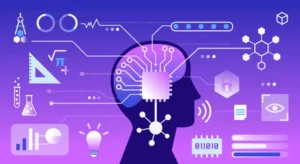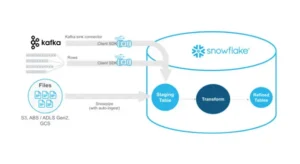
How Businesses Use LLMs for Competitive Intelligence to Stay Ahead of the Curve
How Businesses Use LLM’s for Data-Driven Competitive Intelligence to stay ahead of the curve
Organizations rely on comprehensive data warehouse solutions to manage substantial volumes of data while ensuring efficiency and scalability. Snowflake, via its unique architecture that segregates computation and storage, has transformed data management for enterprises. Nonetheless, efficiently expanding these resources, particularly in cost-sensitive contexts, might prove to be difficult. This blog will look at optimal strategies for scaling data warehouses in Snowflake to get cost-efficient performance.
Using LLMs for Competitive Intelligence
- Keeping an eye on market trends
Large datasets from various sources can be processed by LLMs to identify new trends in industry changes, technology, and customer behaviour. Businesses use this information to identify risks and opportunities before competitors do.
- Monitoring the Strategies of Competitors
LLMs observe the actions of competitors by analysing press releases, earnings calls, and product launches. This makes it possible for companies to modify their marketing plans, pricing, and innovation initiatives.
- Sentiment analysis and social media
LLMs evaluate consumer sentiment towards competitors’ goods and services by monitoring social media sites like Reddit, LinkedIn, and Twitter. This helps businesses improve their products according to customers’ preferences.
- Automated Report Generation
By generating comprehensive assessments based on real-time data, LLMs can improve accuracy and save time compared to manually generating competitive reports.
- Price and Product Modifications
To recommend the best pricing plans and product enhancements, LLMs analyse the price adjustments made by competitors as well as customer feedback.
Real-World Examples of Companies Using LLMs For Competitive Intelligence
1. Unilever
Unilever uses LLMs to study consumer preferences and track competitors like Nestlé and P&G. Their offshore AI solutions process reports, customer reviews, and social media discussions to forecast emerging trends.
For example, Unilever used AI-driven insights to speed up the introduction of its vegan product range under brands like Magnum and Hellmann’s when plant-based diets became more popular. Unilever maintains its lead in innovation by keeping an eye on competitors’ product launches and price policies.
2. Salesforce
Salesforce gives organisations access to real-time competitive intelligence by integrating LLMs into its Einstein AI. To identify market trends and pricing strategies, the AI analyses competitor websites, industry reports, and consumer reviews.
For example, a SaaS business that uses Salesforce can obtain AI-generated insights about the newest feature changes, customer pain areas, and how competitors market their goods. This enables sales teams to modify their product offerings and pitches as necessary.
3. Nike
Nike tracks social media sentiment and analyses competitors like Adidas and Puma using AI-driven competitive intelligence. LLMs keep an eye on conversations on customer experiences, sustainability initiatives, and new shoe releases on Twitter, Instagram, and TikTok.
Nike modifies marketing efforts and product designs to conform to consumer expectations by analysing these insights. For example, Nike can step up its eco-friendly initiatives to remain competitive if Adidas’ sustainable sneaker line becomes popular.
4. Airbnb
LLMs are used by Airbnb to analyse competitor listings, reviews, and pricing patterns in various markets. To provide the best prices for hosts depending on demand, seasonality, and competitor rates, the AI analyses data from competitors like as Booking.com and VRBO.
Airbnb makes sure its hosts have competitive pricing strategies by closely observing changes in the short-term rental market, which raises occupancy rates and profits.
5. Pfizer
Pfizer tracks clinical trials, regulatory changes, and drug approvals using AI-driven competitive intelligence. The business uses LLMs to search government reports from the FDA and EMA, competitor news releases, and medical publications.
For example, Pfizer’s AI system instantly assessed the possible market impact of Moderna’s announcement of new mRNA vaccine advancements. Pfizer was able to better plan its own research investments and market positioning accordingly.
6. Netflix
Netflix uses LLMs to analyse social media discussions, competitor content releases, and viewer preferences. The AI monitors the performance of services like Disney+, Amazon Prime, and HBO Max in various geographical areas as well as the types of content that are popular.
For example, to retain its watchers, Netflix increased its investment in sci-fi and fantasy content as Disney+ began to attract new members with Star Wars spin-offs and Marvel. Netflix ensures it creates the appropriate content to sustain its supremacy by using AI-driven competitive intelligence.
7. Tesla
Tesla uses LLMs to monitor news from around the world, changes to regulations, and competition in the EV industry. Through the analysis of news releases and financial reports from firms such as Lucid Motors, BYD, and Rivian, Tesla can identify critical advancements in battery technology, factory expansions, and price adjustments.
For example, Tesla responded to Ford’s announcement of a Mustang Mach-E price reduction by lowering the costs of its Model Y to stay competitive in the market. Compared to conventional market research techniques, LLMs enable Tesla to predict and respond to competition strategies more quickly.
Future of Competitive Intelligence with LLMs
- Predictive Analysis: Using past data, AI models will predict future trends in addition to tracking changes in the market.
- Automated Decision-Making: Companies will depend more and more on AI-generated suggestions for marketing, pricing, and R&D investments.
- Better Personalisation: Businesses will use real-time competition data analysis to improve marketing strategies and product recommendations.
- In rapidly evolving markets, companies that successfully integrate LLMs into their competitive intelligence processes will have a major edge.
Conclusion
Companies that partner with offshore AI solutions providers can do this at scale and speed, gaining long-term competitive advantages.
By allowing companies to track market trends, analyse competitor strategies, and modify their tactics instantly, LLMs have completely changed competitive intelligence. Businesses such as Unilever, Nike, Airbnb, Pfizer, Netflix and many more serve as examples of how AI-driven insights can propel success in a variety of industries.
If you’re ready to embark on this journey and need expert guidance, subscribe to our newsletter for more tips and insights, or contact us at Offsoar to learn how we can help you build a scalable data analytics pipeline that drives business success. Let’s work together to turn data into actionable insights and create a brighter future for your organization.

Open AI GPT4 Oil Gas
How OpenAI GPT-4.5 Integration Is Changing Oil & Gas Operations In the past year, GPT-4.5 has evolved beyond chatbots and entered the world of heavy industry. For oil & gas

How LLMs Are Revolutionizing Text Mining and Data Extraction from Unstructured Data
Leveraging LLMs for Advanced Text Mining and Data Extraction from Unstructured Data Since digital transformation is growing exponentially, businesses generate huge amounts of unstructured data from sources like emails, PDFs,

How Businesses Use LLMs for Competitive Intelligence to Stay Ahead of the Curve
How Businesses Use LLM’s for Data-Driven Competitive Intelligence to stay ahead of the curve Competitive intelligence (CI) is essential for keeping a competitive edge in today’s fast-paced business world. Businesses

Maximizing Cost-Efficient Performance: Best Practices for Scaling Data Warehouses in Snowflake
Maximizing Cost-Efficient Performance: Best Practices for Scaling Data Warehouses in Snowflake Organizations rely on comprehensive data warehouse solutions to manage substantial volumes of data while ensuring efficiency and scalability. Snowflake,

Comprehensive Guide to Implementing Effective Data Governance in Snowflake
Mastering Data Governance with Snowflake: A Comprehensive Guide Data governance is a systematic way to manage, organize, and control data assets inside an organization. This includes developing norms and policies

Efficiently Managing Dynamic Tables in Snowflake for Real-Time Data and Low-Latency Analytics
Managing Dynamic Tables in Snowflake: Handling Real-Time Data Updates and Low-Latency Analytics In this data-driven environment, businesses aim to use the potential of real-time information. Snowflake’s dynamic tables stand out





